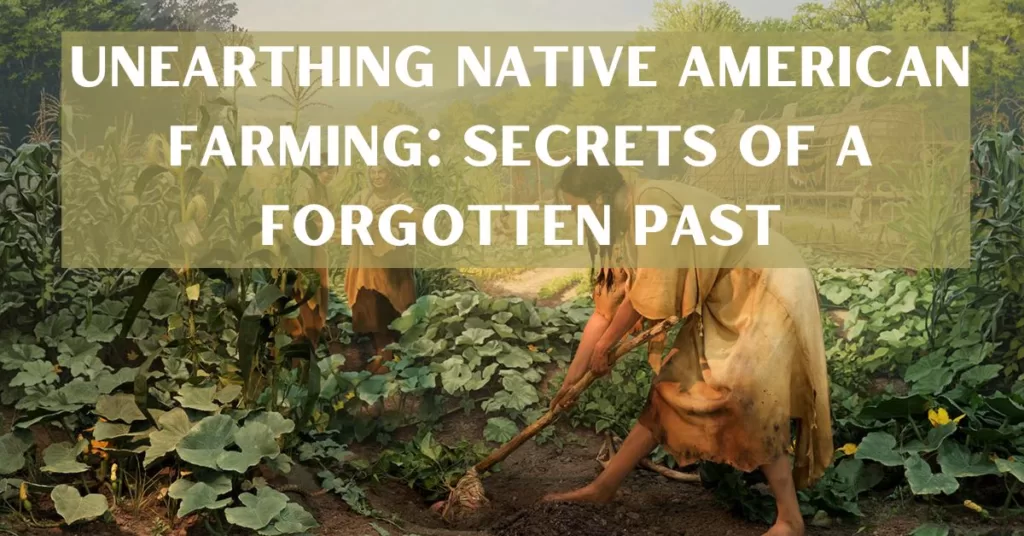Native American farming has left an indelible mark on the agricultural landscape, shaping generations of sustainable practices and innovative techniques. In this article, we’ll delve into the rich history of Native American agriculture, exploring the origins of these ancient farming methods, their unique tools and implements, and the lasting impact they’ve had on modern agriculture. We’ll also discuss the importance of preserving this invaluable heritage and the role of education and cultural exchange in keeping these traditions alive. Join us as we unearth the secrets of a forgotten past and discover the enduring legacy of Native American farming.
Table of Contents
The Origins of Native American Agriculture
Delving into the rich history of Native American agriculture, we discover an intricate tapestry of farming techniques and practices that have stood the test of time. These ancient methods, rooted in a deep respect for the natural world and an understanding of its delicate balance, have left an indelible mark on the landscape of North America. As we begin our journey into the origins of Native American farming, we will explore the pivotal role of the Three Sisters—corn, beans, and squash—and examine how these agricultural practices spread and evolved among various indigenous tribes. This exploration will not only reveal the ingenuity of Native American farmers but also uncover valuable lessons that can be applied to modern sustainable agriculture.
The Three Sisters and their importance
At the heart of Native American agriculture lies the ancient practice of growing the Three Sisters: corn, beans, and squash. This time-honored technique is based on a symbiotic relationship between these three plants, which together form a complete and sustainable agricultural system. Corn provides a natural trellis for the beans to climb, while the beans, as nitrogen-fixing plants, enrich the soil and support the growth of the corn. Squash, with its broad leaves, shades the ground, helping to retain moisture and prevent the growth of weeds.
The Three Sisters were not only significant for their agricultural advantages but also held immense cultural and spiritual value for Native American tribes. Each plant represented a different aspect of life, and their interconnected growth symbolized the importance of unity and interdependence within the community. The nutritional benefits of these crops were also noteworthy, as they provided a balanced diet rich in essential vitamins, minerals, and protein.
The Three Sisters of Indigenous American Agriculture
The spread of agriculture across native tribes
Native American agriculture was a diverse and dynamic practice that extended far beyond the cultivation of the Three Sisters. As tribes migrated and established trade routes across the continent, the exchange of seeds, plants, and agricultural knowledge flourished. This led to the development of region-specific farming methods, adapted to local climates and conditions. For example, the Hohokam people of the Southwest constructed sophisticated irrigation systems to harness scarce water resources, while the Iroquois of the Northeast utilized slash-and-burn techniques to clear land for planting.
The widespread adoption of agriculture among Native American tribes transformed their societies and ways of life. Farming allowed for the establishment of permanent settlements, which in turn fostered the growth of complex social structures and the development of unique cultural traditions. This remarkable agricultural legacy, spanning from coast to coast, demonstrates the ingenuity and adaptability of Native American farmers in the face of diverse environmental challenges.
As we delve deeper into the world of Native American farming, we uncover the myriad ways in which these ancient agricultural practices have shaped the land and its people. From the iconic Three Sisters to the multitude of regional farming techniques, the story of Native American agriculture is one of resilience, innovation, and unity. By embracing the lessons of the past, we can continue to cultivate a sustainable and vibrant future that honors the rich heritage of the indigenous peoples who first tended this land.
Ingenious Native American Farming Techniques
As we continue our exploration of Native American farming, we encounter a treasure trove of ingenious techniques that showcase the remarkable adaptability and resourcefulness of indigenous peoples. These methods, often tailored to the unique challenges and opportunities presented by diverse environments, have shaped the land and its ecosystems for centuries. In this section, we will delve into some of these fascinating Native American farming techniques, including the use of mounds and raised beds, no-till practices, and natural irrigation systems. By examining these ancient practices, we can gain valuable insights into sustainable farming methods that have endured the test of time and can still inform our modern agricultural practices today.
The use of mounds and raised beds
Native American farmers were well aware of the benefits of cultivating crops in mounds and raised beds, which offered numerous advantages for plant growth and soil health. These elevated planting surfaces improved soil drainage, helping to prevent root rot and other diseases caused by excess moisture. Additionally, mounds and raised beds allowed for better air circulation around plants, reducing the risk of fungal infections and improving overall plant health. By creating microclimates that moderated soil temperature and moisture levels, these innovative planting techniques contributed to higher crop yields and increased food security for indigenous communities.
No-till and organic farming methods
Long before the advent of modern organic agriculture, Native American farmers were practicing no-till and chemical-free farming methods that preserved the integrity of the soil and promoted a healthy ecosystem. By refraining from tilling the soil, these ancient farmers reduced soil erosion and maintained the delicate balance of microorganisms necessary for fertile, productive soil. They also used natural fertilizers, such as compost and animal manure, to enrich the soil without resorting to harmful chemicals. This early form of organic farming demonstrated an intimate understanding of the land and its ecosystems, embodying a sustainable approach to agriculture that remains relevant to this day.
Harnessing natural resources for irrigation
Native American farmers were masters of resourcefulness, skillfully utilizing available natural resources to irrigate their crops. In the arid Southwest, tribes like the Hohokam and Ancestral Puebloans developed sophisticated irrigation systems using canals, ditches, and check dams to channel scarce water resources to their fields. In the Eastern Woodlands, indigenous farmers took advantage of the region’s abundant water sources, such as rivers and streams, to create small-scale irrigation systems that sustained their crops during dry spells. By harnessing the power of nature, these innovative farmers maximized their agricultural potential and ensured the survival and prosperity of their communities.
Native American Farming Tools and Implements
In the world of Native American farming, the tools and implements used by indigenous farmers were not only practical and efficient but also held cultural and spiritual significance. Crafted from locally sourced materials such as stone, bone, and wood, these handcrafted tools were designed to suit the specific needs of the farmers and their environment. As we explore the fascinating realm of Native American farming tools, we will gain a deeper understanding of the innovation and resourcefulness that defined these ancient agricultural practices. In this section, we will shed light on the unique designs and uses of these farming implements and how they contributed to the success and resilience of Native American agriculture.
Handcrafted tools from stone, bone, and wood
Native American farmers crafted their farming tools and implements using locally available materials such as stone, bone, and wood. These handcrafted tools were not only durable and functional but also reflected the deep connection between the indigenous peoples and their natural surroundings. Stone tools, like the hoe and grinding stone, were used for tilling the soil and processing harvested crops. Bone tools, like awls and needles, were used for various tasks, including planting seeds and mending farming equipment. Wooden tools, such as digging sticks and wooden spades, were essential for breaking up soil, planting, and harvesting crops. These handcrafted tools, both practical and sustainable, allowed Native American farmers to work in harmony with their environment and cultivate a thriving agricultural landscape.
Innovations in tool design and usage
The ingenuity of Native American farmers extended beyond the materials they used and into the design and usage of their farming tools. These innovative designs often reflected a deep understanding of the local environment and the specific needs of the crops they cultivated. For example, the uniquely shaped hoe, with its broad, flat blade, was expertly designed to break up the soil without damaging delicate plant roots. Another innovation was the atlatl, a spear-throwing device that enabled indigenous farmers to protect their crops from pests and predators with increased accuracy and efficiency. These innovations in tool design and usage, rooted in generations of accumulated knowledge and experience, played a crucial role in the success and resilience of Native American agriculture.
The Impact of Native American Farming on Modern Agriculture
The rich legacy of Native American farming extends far beyond the ancient fields and gardens cultivated by indigenous peoples. Today, modern agriculture continues to be shaped and inspired by the wisdom, innovation, and sustainable practices of these early farmers. As we examine the impact of Native American farming on contemporary agriculture, we will uncover the valuable lessons and techniques that have endured the test of time, and how they are being applied to address modern-day challenges. In this final section, we will delve into the influence of Native American farming on sustainable agriculture, heirloom crop preservation, and the ongoing quest for food security in a rapidly changing world.
Sustainable practices inspired by ancestral wisdom
Modern agriculture has much to learn from the sustainable practices of Native American farmers, who cultivated the land with a deep respect for the environment and the natural resources it provided. Techniques such as no-till farming, crop rotation, and companion planting, which have become increasingly popular in the realm of sustainable agriculture, find their roots in ancient indigenous wisdom. By embracing these ancestral practices, contemporary farmers can work towards reducing the environmental impact of agriculture and contribute to a more sustainable and resilient food system for future generations.
The revival of indigenous crops and biodiversity
Another significant impact of Native American farming on modern agriculture is the growing interest in preserving and promoting indigenous crops and biodiversity. Heirloom varieties of corn, beans, squash, and other native crops offer valuable traits such as drought tolerance, disease resistance, and enhanced nutritional content. By reintroducing these indigenous crops into modern farming systems, we can harness their unique qualities to strengthen the resilience of our food supply and promote biodiversity in our agricultural landscapes. The revival of these ancient crops also serves as a powerful symbol of the enduring influence of Native American farming on the agricultural practices of today and tomorrow.
Preserving Native American Farming Heritage
As we’ve journeyed through the rich history of Native American farming, it becomes increasingly clear that preserving and celebrating this heritage is vital not only for honoring the past but also for ensuring a sustainable future. The indigenous wisdom, techniques, and crops that have shaped the landscape of American agriculture for centuries deserve recognition and continued cultivation. In this concluding section, we will explore the importance of preserving the Native American farming heritage, as well as the efforts being undertaken by individuals, communities, and organizations to keep this rich legacy alive. By embracing the lessons of the past, we can forge a path towards a more sustainable and equitable future for all.
The role of educational initiatives and community projects
Educational initiatives and community projects play a crucial role in preserving Native American farming heritage. By sharing the history, techniques, and values of indigenous agriculture, these initiatives help to raise awareness, foster appreciation, and encourage the adoption of sustainable farming practices. Schools, museums, and cultural centers can offer workshops, exhibits, and demonstrations that showcase the rich legacy of Native American farming. Community gardens and urban farming projects can provide hands-on learning opportunities, allowing people to experience the benefits of indigenous agricultural practices firsthand. By engaging in these initiatives, we can ensure that the wisdom and knowledge of Native American farming continue to enrich future generations.
The importance of cultural exchange and knowledge sharing
Cultural exchange and knowledge sharing are essential in preserving the Native American farming heritage. By fostering dialogue and collaboration between indigenous communities, farmers, researchers, and educators, we can work together to safeguard and promote the rich agricultural traditions of Native American peoples. Cross-cultural exchanges can help to break down barriers, dispel misconceptions, and build bridges of understanding and respect between diverse communities. By sharing the valuable lessons and insights gleaned from generations of indigenous farming experience, we can collectively advance towards a more sustainable, resilient, and equitable agricultural future.
Conclusion
In conclusion, the lasting legacy of Native American farming offers us invaluable lessons and inspiration for the future of agriculture. The sustainable practices, innovative techniques, and diverse crops cultivated by indigenous peoples for centuries have shaped the American agricultural landscape and continue to influence modern farming. By preserving and celebrating this rich heritage, we can ensure that the wisdom and knowledge of Native American farming endure and inspire future generations. By embracing these ancient techniques and fostering cultural exchange, we can work together to create a more sustainable, resilient, and equitable food system for all.

Joyce Ann Tyldesley is a renowned British archaeologist, Egyptologist, writer, and broadcaster.






